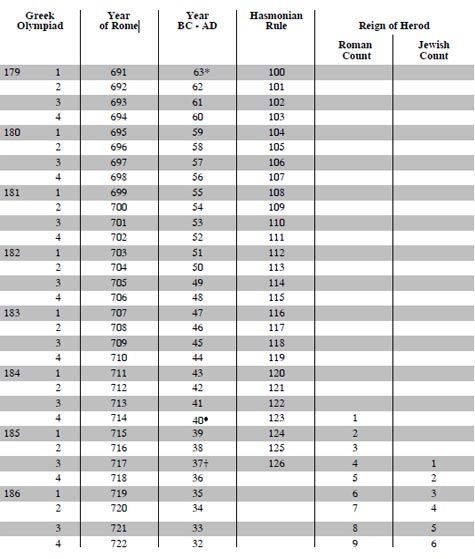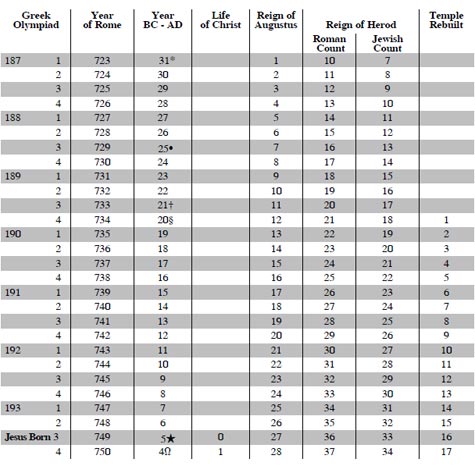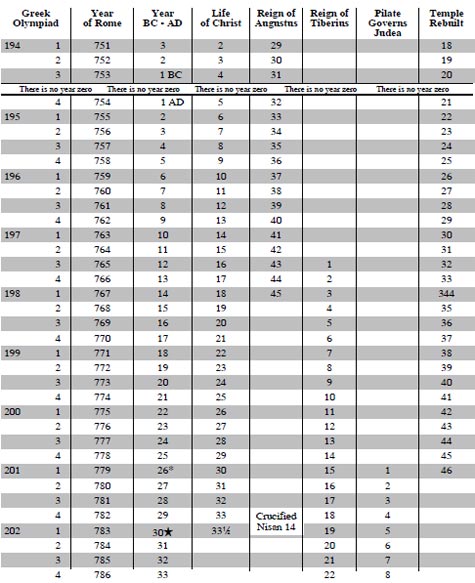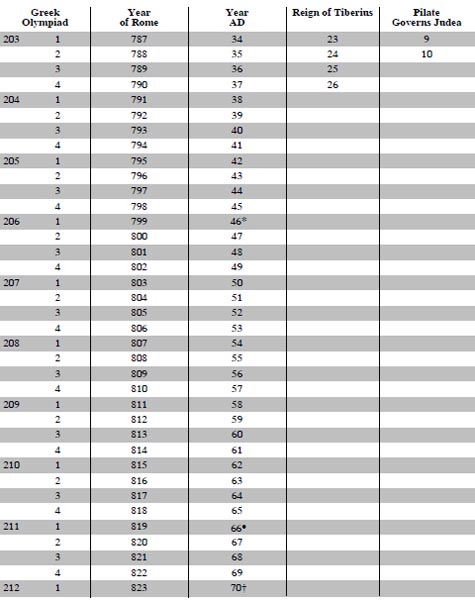Appendix F
A Synchronized Chart of
Historical and Scriptural Records
That Establish the Year of Christ’s Birth
Few Bible students realize that a vast amount of evidence is available with which to prove the year of Jesus’ birth. In keeping with the biblical principle that a matter should be established by the testimony of two or three witnesses (Deut. 17:6; Matt. 18:16; etc.), we find that there are indeed three witnesses—history, Scripture and astronomy—which corroborate the year of Christ’s birth. These three witnesses combined build a valid case, proving conclusively that Jesus was born in the fall of 5 BC.
The primary scriptural records are those provided by Matthew and Luke. The astronomical evidence includes the full lunar eclipse of September 15, 5 BC, used to pinpoint the time of Herod’s death. (See Appendix E, “When Was Jesus Christ Born?”, p. 1258.)
The primary historical references that enable us to determine when Christ was born are those of Roman historians and of the Jewish historian Josephus, who lived from about 37 AD to 100 AD. These secular records can be used to establish the reign of Herod the Great, who attempted to kill the infant Jesus. Josephus records the names of the consuls who ruled in Rome at the time that Herod began his reign. Lists of all the consuls who ruled during the years from 509 BC to 337 AD have been preserved by Roman historians, giving us an exact time frame for dating the reign of Herod, which is essential to identifying the year of Christ’s birth.
Josephus records that Herod received the kingdom in Rome in the 184th Olympiad (Antiquities, 14:14:5). Each Olympiad was four years in length, with the years being reckoned from July 1 through June 30. The 184th Olympiad was from July 1, 44 BC, to June 30, 40 BC. Josephus also records that Herod began his reign when Calvinus and Pollio were consuls of Rome. Calvinus and Pollio were consuls from January 1, 40 BC, to December 31, 40 BC. Since the 184th Olympiad ended on June 30, 40 BC, it is evident that the reign of Herod as king in Rome began sometime between January 1, 40 BC, and June 30, 40 BC.
According to Josephus, Herod reigned thirty-seven years from the time of his coronation in Rome (Antiquities of the Jews, 17:8:1; Wars of the Jews, 1:33:8). Consequently, the end of his reign occurred sometime between January 1, 4 BC, and June 30, 4 BC. Since Jesus was born during the final months of Herod’s reign, the historical facts limit the time of His birth to the period from June 30, 5 BC, to June 30, 4 BC. Because the Gospels place His birth during the fall festival season, the time is further limited to the year 5 BC.
The historical and scriptural records are presented in chart form on the following pages.
* 63 BC
 40 BC
40 BC
† 37 BC
Jerusalem captured by Roman general Pompey during 179th Olympiad. Antonius and Cicero are Roman consuls (Josephus, Ant., 14:4:3).
Herod receives kingdom in Rome during 184th Olympiad. Calvinus and Pollio are Roman consuls (Josephus, Ant., 14:14:5).
Hasmoneans’ 126-year rule of Jerusalem ends during 185th Olympiad. Herod receives kingdom in Jerusalem. Agrippa and Gallus are Roman consuls (Josephus, Ant., 14:16:4).
Synchronized Chart Establishing the Year of Christ’s Birth
* 31 BC
 25 BC
25 BC
† 21 BC
§ 20 BC
 5 BC
5 BC
Ω 4 BC
Battle of Actium, seventh year of Herod’s reign, 187th Olympiad (Josephus, Ant., 15:5:1; 15:5:2).
Two-year famine begins in Herod’s thirteenth year (Josephus, Ant., 15:9:1).
Augustus visits Syria during seventeenth year of Herod’s reign; Apuleius and Silvius are Roman consuls (Dio’s Roman History, LIV:7:4-6; Josephus, Ant., 15:10:3).
Construction of Herod’s temple begins in Herod’s eighteenth year (Josephus, Ant., 15:11:1).
Jesus born during fall festival season—most likely on the Feast of Trumpets.
Herod dies in thirty-seventh year of having received kingdom in Rome and thirty-fourth year of having received kingdom in Jerusalem (Josephus, Ant., 17:8:1; Wars, 1:33:8).
* 26 AD
 30 AD
30 AD
Pontius Pilate assumes governance of Judea (Luke 3:1).Jesus begins ministry at about age thirty (Luke 3:23). Herod’s temple 46 years in building (John 2:20).
Jesus crucified, Wednesday, April 5, 30 AD – The Passover Day, Nisan 14.
* 46 AD
 66 AD
66 AD
† 70 AD
The apostle Paul begins his missionary journeys.
Jewish wars begin.
Destruction of Temple occurs.

 Contact Webmaster
Contact Webmaster Copyright © 2025 A Faithful Version. All Rights Reserved







